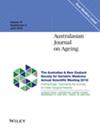Postoperative delirium increases follow-up mortality following hip arthroplasty in older patients with femoral neck fracture
Abstract
Objective
This study aimed to identify independent perioperative risk factors and follow-up mortality associated with postoperative delirium in older patients undergoing hip arthroplasty at a large teaching hospital in South China. We aimed to establish a specialised model to predict the risk of postoperative delirium.
Methods
This retrospective observational study was conducted in the orthopaedics department of the hospital between January 2018 and December 2022. Participants were stratified into two groups: those with and those without postoperative delirium. The study included demographics, clinical characteristics, surgery-related and laboratory specifics, as well as details on delirium.
Results
In this study of 241 participants, the median age was 80 years (IQR, 74.5–85), with postoperative delirium observed in 43 individuals (18%). Multivariate logistic regression analysis identified age (OR, 1.07; 95% CI, 1.01–1.14; p = .03), arrhythmia (OR, 7.97; 95% CI, 2.25–28.29; p = .001), dementia (OR, 7.08; 95% CI, 1.73–28.95; p = .006) and a lower level of red blood cells (RBC) (OR, .33; 95% CI, .17–.64; p < .001) as independent factors associated with postoperative delirium after hip arthroplasty. Patients experiencing both preoperative and postoperative delirium had significantly higher follow-up mortality compared to those with postoperative delirium only and those without delirium (80% vs. 38% vs. 24%, p = .02).
Conclusions
The specialised model was established to effectively predict delirium following hip arthroplasty in patients with femoral neck fracture. Postoperative delirium strongly associates with follow-up mortality. Proactive management is crucial for minimising delirium occurrence after hip arthroplasty and improving patient outcomes.


 求助内容:
求助内容: 应助结果提醒方式:
应助结果提醒方式:


